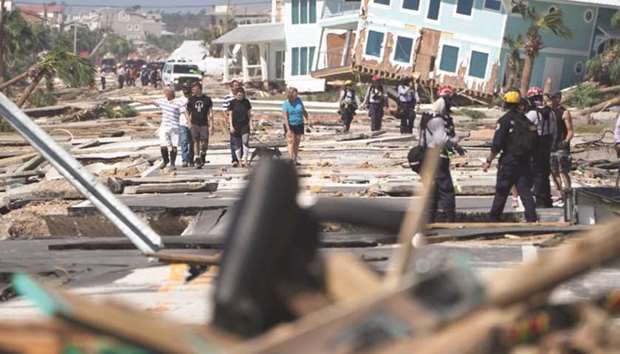Rescue crews worked their way through fallen trees and heaps of rubble yesterday in the Florida Panhandle towns hit the hardest by Hurricane Michael, looking for people trapped or killed by a storm blamed for at least 14 deaths.
The concern was for people who ignored evacuation orders ahead of the storm – which grew with surprising speed from a tropical storm into an extremely powerful Hurricane in less than two days – and who stayed put in communities that were demolished by Michael’s assault on Wednesday.
“I think you’re going to see it climb,” Brock Long, administrator of the Federal Emergency Management Agency (FEMA), said of the death count at a news conference. “We still haven’t gotten into some of the hardest-hit areas.”
FEMA crews used heavy equipment, sniffer dogs, drone aircraft and global positioning satellites in their search.
So far, counties along the affected northwest Florida coast have reported no deaths related to the storm.
Michael charged ashore near the small Florida Panhandle town of Mexico Beach as one of the most powerful storms in US history, with winds of up to 155mph (250kph).
It pushed a wall of seawater inland, causing widespread flooding.
The storm, a Category 4 on the five-step Saffir-Simpson scale, tore apart entire neighbourhoods in the Panhandle and many houses in Mexico Beach were reduced to naked concrete foundations or piles of rubble.
A search-and-rescue operation led by the FEMA did not find any fatalities in Mexico Beach as of morning yesterday, but Donald Walker, the town’s interim fire chief, said that is likely to change.
Phone service to the most damaged areas was down, leaving survivors no way to contact worried relatives.
A CNN reporter on the air read off names of residents he had spoken with, to let concerned parties know they were safe.
Clean-up operations were cranking up throughout the Panhandle.
About 40 Army officers were sent to clear roads near the small beach town of Alligator Point.
In the coastal community of Panacea, 60 miles (96km) east of where Michael made landfall, Jasmine McMillan, 42, contemplated the damage at the commercial campground her family owns on Ochlockonee Bay.
“We lost our dock. It’s washed away,” she said. “All these electrical poles and water lines are busted.”
The campground had been full just before Michael blew in and covered it in 2’ (61cm) of debris and seaweed, McMillan said.
Florida Senator Bill Nelson went to Panama City, up the coast from Mexico Beach, and was stunned by what he saw.
“Pine forests were no longer – they were all sticks that were broken in two,” Nelson, a Democrat, told Fox News. “Mexico Beach, there’s no barrier island out there to protect it so it got the full force of the Category 4 wind and that wall of water.”
Although weaker as it pushed over southeastern US, the storm carried high winds and delivered drenching rains to Georgia, the Carolinas and Virginia.
It killed at least four people in Florida, five in Virginia, three in North Carolina and two in Georgia, officials said.
About 1.5mn homes and businesses were without power from Florida to Virginia yesterday, according to utility companies.
It could be weeks before power is restored to the most damaged parts of Florida.
The FEMA’s Long urged communities such as Mexico Beach, where many homes were obliterated by 12’ to 14’ (3.7m to 4.3m) of storm surge, to rebuild to withstand future storms.
“It’s OK if you want to live on the coast or on top of a mountain that sees wildfires or whatever but you have to, build to a higher standard,” he said. “If we’re going to rebuild, do it right.”
By morning yesterday the remnants of Michael had moved into the Atlantic Ocean northeast of Norfolk, Virginia, but still could bring up to 5” (13cm) of rain to parts of New England, the National Hurricane Centre said.
The number of people in emergency shelters was expected to swell to 20,000 across five states, said Brad Kieserman of the American Red Cross.
The Coast Guard reported rescuing 129 people.

First responders and residents walk along a main street following Hurricane Michael in Mexico Beach, Florida.
